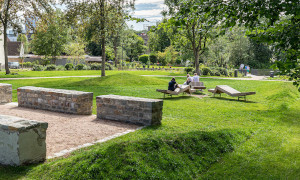3rd bdla Plant Planner Days on 21 and 22 June 2019 in Freising
The interest in the third edition of the Plant Planner Days was also great: Around 300 participants came to the Weihenstephan-Triesdorf University of Applied Sciences in Freising on 21 and 22 June 2019. Swantje Duthweiler, professor for plant use at the university and chairwoman of bdla-Bayern, had conceived the advanced training event and invited twelve renowned speakers who addressed the topic of plants in a multi-layered way: The agenda ranged from substrates, care and plant selection to innovative design concepts to digitalization and concepts tailored to animals. Across disciplines, planners and scientists alike were moved by the question of which plants will have a future under the impact of climate change, urban redensification and limited budgets.
"Trees with a future" sought
The conference began with the soil as the basis for plant thriving and the remarks of soil expert Johannes Prügl from Au in der Hallertau. He gave practical advice on the tendering of substrates and pointed out that, in view of climate change, trees will need considerably more root space in the future. Large tree pits are naturally not an issue in green roofs, which were presented by Prof. Manfred Köhler. Together with his team from Neubrandenburg University of Applied Sciences, he had studied between 1999 and 2015 how the vegetation of a simply intensively greened roof in the district of Pinneberg changed without maintenance. During this period, established woody plants such as the sand birch had become problematic and had grown too tall due to seed growth.
Klaus Körber picked up on this hint and began his subsequent presentation with a remark aimed at the summer of 2018: "There are regions where we would be happy if a birch flew onto the roof and survived." The head of the fruit-growing and tree nursery department at the Bavarian State Institute in Veitshöchheim named species in his lecture "Trees with a future" that could withstand climate change according to current knowledge. Jan van Merriënboer from the Larenstein University of Applied Sciences in the Netherlands used the example of Amsterdam to demonstrate that, given the right political will, trees also have a future in cities with difficult site conditions. The city is not only pursuing the goal of increasing the number of trees, but is also designing street spaces that retain water after heavy rainfall and make it available for plants. The latter approach, which is becoming increasingly important under the impression of weather extremes, was presented by Daniel Zimmermann, 3:0 Landschaftsarchitektur in Vienna, under the catchphrase "sponge city" using the example of the Seestadt in Vienna.
Peter Janke of HORTVS Gartenkonzepte in Hilden operates on a smaller scale, but nevertheless in the field of tension of extreme weather events. He considers a high number of species in the private gardens he has designed since last summer to be important from a functional point of view as well. Isolated drought-conditioned losses of plants are better compensated in such a way. Harald Sauer, horticultural manager of the Ebertpark in Ludwigshafen, also demonstrated that diversely composed plantings are also beautiful. Sauer presented his plantings for the Ebertpark and the city's main cemetery, where he not only takes aesthetic but also unconventional approaches. Among other things, he increases acceptance of weeds by aestheticizing them.
The importance of appreciating nettles and other weeds in terms of living open spaces was explained by Prof. Wolfgang Weisser from the Technical University of Munich and Dr. Thomas Hauck from the University of Kassel. Under the heading of "Animal Aided Design", they are developing ideas that make urban spaces specifically attractive for certain animal species. Prof. Olaf Schroth from the Weihenstephan-Triesdorf University of Applied Sciences and Philip Paar (Laubwerk GmbH in Potsdam) spoke about the possibilities and limitations of digital visualizations of plants and planting plans. Prof. Mark Krieger from the University of Applied Sciences Rapperswil in Switzerland continued to draw his planting concepts by hand, which he explained to the conference participants. In his presentation, he emphasized that it is not the chosen method of presentation, but the subsequent care that determines the future of a plantation.
Botanical gems visited
At the end of the Plant Planner Days, there was the opportunity to take part in one of the three excursions: Prof. Irene Lohhaus, Lohaus Carl Köhlmos Landschaftsarchitektur, Hanover, presented the plantings in the new Westpark Augsburg. Horst Kübert and Jochen Eckert, kübertlandschaftsarchitektur, Munich, explained the mixed perennial plantings at the Pater Rupert Mayer School Centre in Pullach and at the primary school on Baierbrunner Straße in Munich. Since the conference building itself was also located in the midst of botanical sights, Swantje Duthweiler, Ulrike Leyhe, Technical Director of the Weihenstephan Gardens, and Prof. Bernd Hertle, Director of Weihenstephan Gardens, led tours through the university's Open Space Laboratory located on Weihenstephaner Berg, the Oberdieck Garden and the Viewing Garden. It is anticipated that the 4th bdla Plant Planner Days 2020 will again take place in June - a month well suited for possible excursions.
The 3rd bdla Planting Planner Days were sponsored by Bruns Pflanzen, Bott Begrünungssysteme and the Runge company and took place in cooperation with the Association of German Nurseries, the Association of German Perennial Gardeners, the Federal Association of Garden, Landscape and Sports Ground Construction, the Landscape Research Society and the Weihenstephan-Triesdorf University of Applied Sciences. Media partner was the magazine "Gartenpraxis", Ulmer Verlag.
- Latitude: 0
- Longitude: 0


